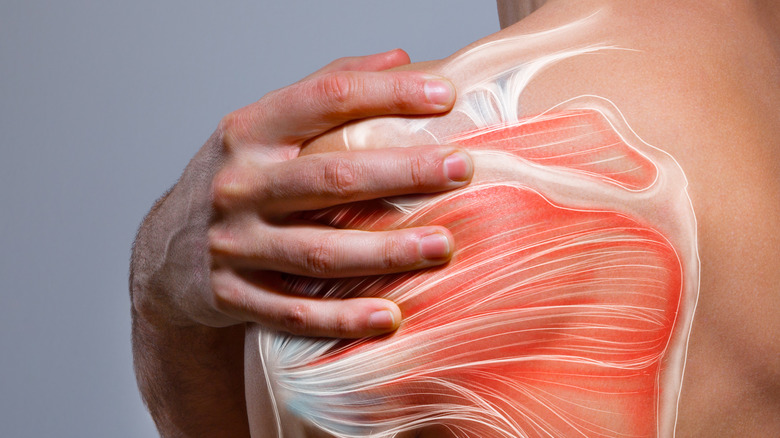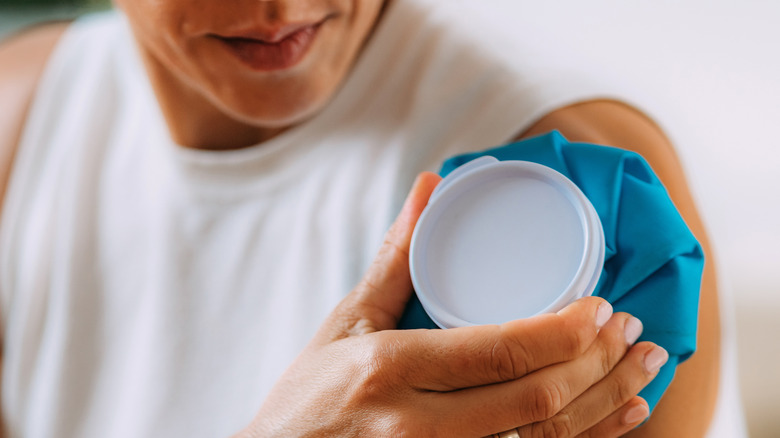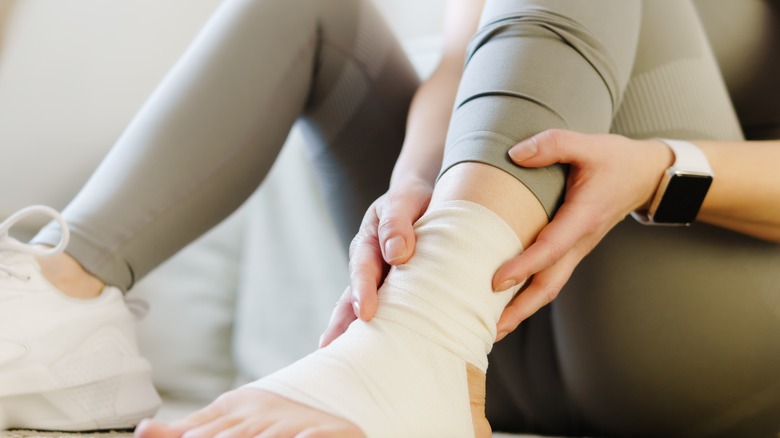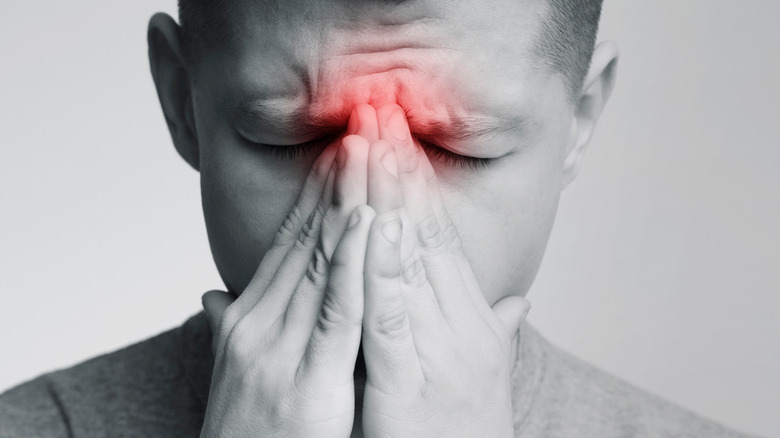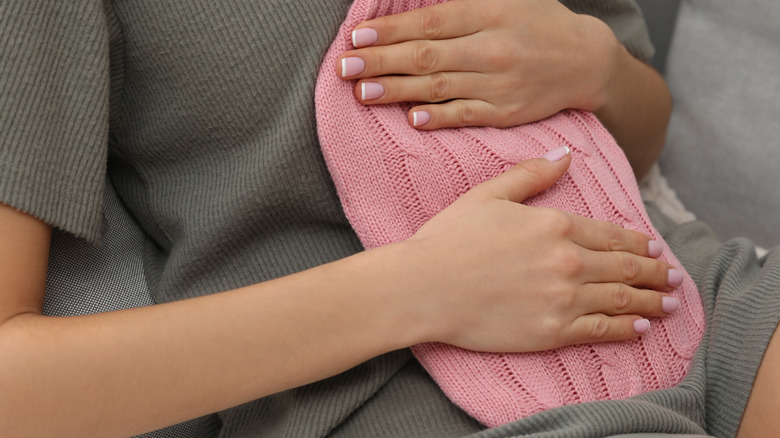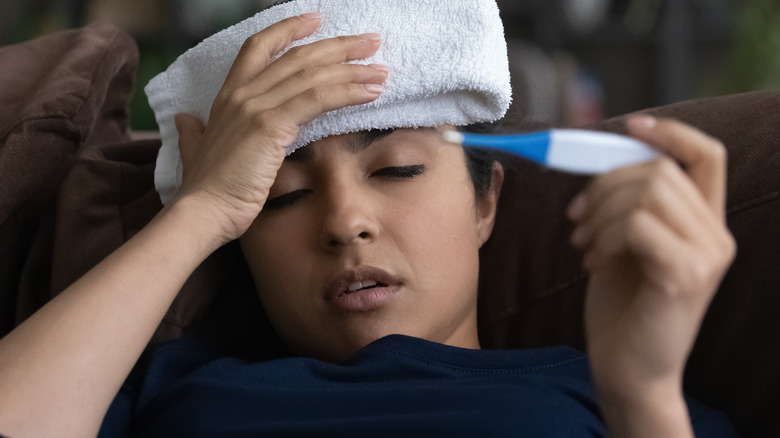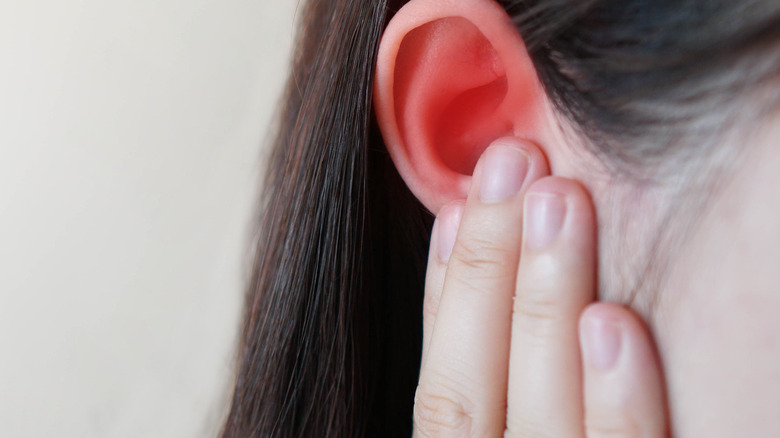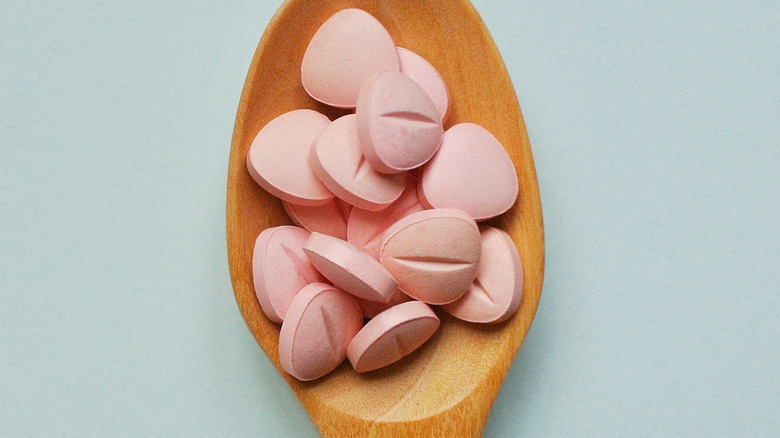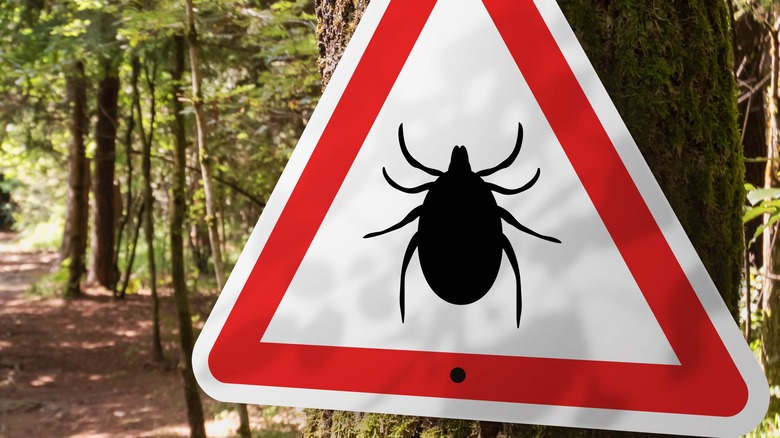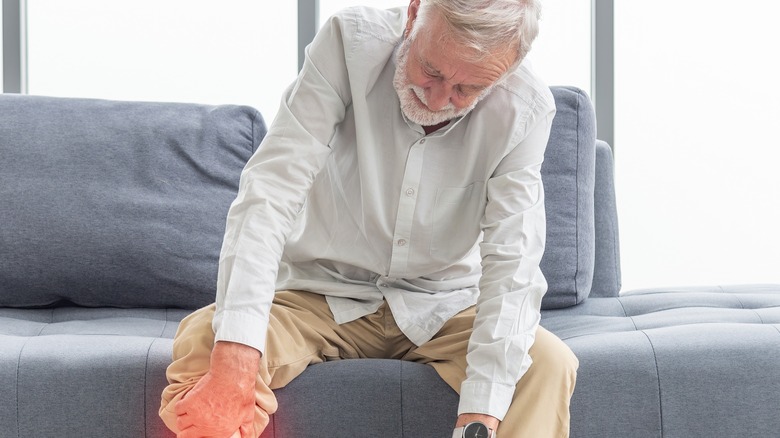13 Possible Causes Of Body Aches
Most people have experienced body aches at some point in their lives. While in some cases they go away on their own without intervention, they can still be very uncomfortable and unsettling, especially if you don't know the source of the pain. As Healthline puts it, body aches can be a symptom of an underlying condition, but can also be caused by something as simple as sitting or standing for extended periods of time.
The experts at K Health explain that some symptoms of body aches are the feeling of your muscles being "weak, sore, tired, or hard to move." Aches are triggered by inflammation in the muscles, and can either come on as sharp, more sudden pains or be characterized by a more persistent, dull, achy feeling. Aches can be triggered by your immune system or through some type of physical trauma.
When aches are accompanied by other symptoms such as fever, chills, or vomiting, it may be easier for you to diagnose the source of the pain and find a solution. If symptoms are isolated, you'll have to use a process of elimination to properly diagnose and treat yourself. To help you out, here is a compilation of different potential causes of body aches.
Stress
The effects of stress on the body can be manifold and complex. According to the American Psychological Association (APA), stress can affect the musculoskeletal, respiratory, cardiovascular, endocrine, gastrointestinal, nervous, and reproductive systems. With all of those systems being affected, it stands to reason, then, that body aches could be a potential side effect of stress.
Experts at the APA explain that when we get stressed, our muscles tense up as our bodies are attempting to protect us from "injury and pain." For those who experience brief moments of stress, the body will tense up momentarily and then release the tension after the stressful moment is over. However, for those who experience ongoing chronic stress, your muscles don't get the luxury of that relief, as they are pretty much always tensely awaiting injury and pain. Tension that is concentrated in the shoulders, neck, and head, for example, can lead to what are called tension headaches. The site explains that lower back pain as well as pain in the "upper extremities" can also be a result of stress.
In order to release tension from temporary or chronic stress, the APA recommends trying relaxation techniques or engaging in "stress relieving activities."
Dehydration
Not only can not drinking enough water leave you thirsty, it can also lead to body aches. According to Healthline, water is necessary for the body to perform basic functions, and when we become dehydrated, we are putting ourselves at risk for a number of negative side effects, including physical pain. The AARP further explains that muscle cramps and muscle weakness are a telltale sign of dehydration. This is typically caused by an imbalance of what are called electrolytes, which limit blood flow to the muscles.
Experts at Livestrong explain that electrolytes are "charged particles" that help the body properly balance its levels of fluids, and also give it energy. Electrolytes can be lost via excessive sweating from working out, or other forms of dehydration (including vomiting and diarrhea). ScienceDaily explains that if you are experiencing muscle cramps as a result of dehydration, re-fueling with electrolytes is a much better bet than simply reaching for a water bottle. Ken Nosaka, a professor from Edith Cowan University's School of Medical and Health Sciences, spoke to the site and explained, "Many people think dehydration causes muscle cramps and will drink pure water while exercising to prevent cramping. We found that people who solely drink plain water before and after exercise could in fact be making them more prone to cramps." Per Cowan, this is because the water further dilutes the amount of electrolytes in your bloodstream.
Lack of sleep
Not getting enough z's may also be a cause of those pesky body aches. A study published in the Journal of Neuroscience found that a lack of sleep can significantly increase levels of body pain. Study author Adam Krause spoke to WebMD and explained, "Activity in the somatosensory cortex, previously associated with the location and intensity of pain, was enhanced following sleep loss." On the other hand, he went on to add, "...in two regions called the striatum and the insula, sleep deprivation decreased the activity associated with pain [relief]."
The study was divided into two parts. In the first part, researchers monitored 25 healthy subjects who got eight hours of sleep the first night. On another night a week later, the subjects got no sleep at all. After both nights, researchers conducted thermal pain sensitivity tests accompanied by brain scans to monitor how the brain responded to administered levels of pain. After the full night of sleep, the subjects registered "heat discomfort" at 111 degrees Fahrenheit. However, after the night of no sleep, the temperature at which they registered discomfort dropped four degrees (107 degrees Fahrenheit).
In the second part of the study, the researchers observed 60 participants who said they experienced pain, and monitored them over two days. After the study, Krause explained, "We found that reductions from one night to the next in the quality of the sleep, rather than just the quantity — total hours asleep — predicted worse pain the following day."
Too much physical activity
If you've ever pushed yourself at the gym and then had trouble completing even the most basic of physical tasks the next day, you know how this one feels.
Medical News Today shares that it is both natural and common for muscles to be sore after physical exertion such as exercise, and that this soreness is typically nothing to worry about, and will dissipate within a matter of days. Experts at the site explain that your muscles elongate and then contract during physical activity facilitating movement. If this is done for an extended period of time, it's possible to overexert your muscles, which may lead to the aforementioned soreness. This soreness typically occurs if the movement is different from what your muscles are normally used to (e.g., exercising new muscles, exercising for longer, higher intensity workouts, etc.). The condition is officially known as delayed onset muscle soreness (DOMS), as it usually sets in "several hours" after your workout is over.
And if you are new to exercise and are feeling the burn, don't feel bad — it can happen to anyone, at any fitness level. The pain will usually "peak" around 24 to 72 hours after the workout, and will later start to fade away.
Muscle strain
While a little soreness after working out may be normal for a couple days, experiencing prolonged pain after physical activity may be a sign of something more serious.
The Mayo Clinic defines a muscle strain as an "injury to a muscle or a tendon." The site explains that muscle strains are also called pulled muscles, and that they typically occur in the lower back muscles as well as the hamstrings. If you've heard of a muscle sprain, experts say they are, in fact, different. A sprain refers to an injury that affects the tissue connecting two bones, while a strain refers to an injury to the muscle or tissue that attaches the muscle to the bone.
While the site explains that symptoms of a strain can vary, some of the more common symptoms include pain, tenderness, redness, limited mobility, spasms, muscle weakness, and swelling. For the most part, strains can be treated at home with "rest, ice, compression and elevation." If the pain persists, it may be necessary to visit a doctor.
Sinus pressure
Headaches can be, well, a pain — and when they are accompanied by infected sinuses, it can feel doubly annoying.
The Mayo Clinic explains that sinus headaches are characterized by "pain, pressure and fullness in the cheeks, brow or forehead," a congested nose, pain that intensifies when you bend down, and exhaustion, among other symptoms. However, it is easy to get migraines and sinus headaches confused as they have similar symptoms. A couple ways the two differ is that sinus headaches are not typically joined by nausea, vomiting, or the sensitivity to bright lights that usually accompany migraines. Sinusitis, on the other hand, is more likely to occur after or during an upper respiratory infection or cold, and will be accompanied by thick mucus as well a decrease in smell.
Per the Cleveland Clinic, sinus headaches are actually a pretty common result of a sinus infection, and that anything — including colds and allergies — that contributes to mucus buildup can cause them. To eliminate sinus headaches, you have to get to the root cause. If your infection is bacterial, for example, taking an antibiotic may be your best line of defense. To treat the symptoms, apply a warm compress to the sinus area, use a decongestant, or use a vaporizer or steam from a hot pot of water.
Menstrual cramps
One of the unfortunate side effects of having a period is that sometimes they can hurt — a lot. Many women have accepted that having pain accompanying their periods is normal, and Healthline says that they are "one of the most common causes of pelvic pain." The pain is a result of "uterine contractions" and that they can last anywhere between a few brief moments to several days. As for how they feel, menstrual cramps tend to manifest as, well, a cramping sensation in the pelvic region, and can also feel like more localized throbbing, or a general achy sensation. If the pain is strong enough, it may even extend to the thigh and lower back area.
If you are experiencing "normal" menstrual cramps, experts say those can typically be treated by taking over-the-counter medication. Severe cramps, on the other hand, both start earlier on in your cycle, last longer, and may not respond well to over-the-counter meds. Additional signs you are experiencing severe cramping include the cramps interfering with your daily life, blood clots, and having a heavy flow.
In general, cramping is caused by prostaglandins, hormones that are released when you bleed. These hormones help the uterus to contract and release its lining. However, if you are experiencing more intense cramps than normal, there could be an underlying condition, so it's best to visit your gynecologist to get yourself checked.
Viral infection
If you've ever had the flu, then you probably know that one of its most telltale symptoms is body aches. However, the flu isn't the only virus that is accompanied by an achy body, and experts at UCLA Health explain just why you may feel this way when a virus of any kind hits you.
One of the main differences between the aches you'll get from a virus versus, say, doing too many squats is that this type of ache is spread throughout your whole body. The reason for the full body aches is that when you get sick, your immune system is triggered and releases a surge of white blood cells. As a result, the body experiences significant inflammation, which is what leads to you feeling achy all over.
While it is annoying, experts say that this is actually a positive sign: it means your body is working hard to actively fight off the virus. When fighting a virus, in addition to body aches, you may experience a fever, muscle weakness, and shivers, among other symptoms. Some ways to help ease the pain including rest, staying hydrated, and taking a warm bath.
Bacterial infection
Another type of infection that may lead you to some discomfort is a bacterial infection. Medical News Today explains that bacterial infections occur when certain types of disease-causing bacteria find their way into the body, multiplying and resulting in infection.
Pain and aches can be associated with bacterial infections and will manifest in different areas of the body, depending on where the infection is. For example, a gastrointestinal infection is an infection that primarily infects the stomach and intestines, and will cause aches in the stomach accompanied by other symptoms, including diarrhea, nausea, loss of appetite, and more. An upper respiratory tract infection targets the nasal and sinus passages, and can lead to sinus pressure, which can cause sinus headaches. An ear infection, on the other hand, may occur in the inner, middle, or outer parts of the ear, and can lead to pain and a generally achy feeling in the ear potentially accompanied by drainage, fever, and fatigue.
With bacterial infections, it is important to identify the source of whatever pain you are experiencing to get proper treatment from your doctor, which may include antibiotics.
Nutrient deficiencies
Nutrient deficiencies are another potential trigger of body aches, for a number of reasons.
Per SFGate, being deprived of certain nutrients can trigger body aches, but symptoms can be improved by reassessing your diet. Studies have shown that a vitamin D deficiency may lead to muscle cramps and aches. Healthline confirms those findings, and explains that both bone and back pain are symptoms of being deficient in this vitamin. A review found that people who reported having "arthritis, muscle pain, and chronic widespread pain" also had less vitamin D compared to those who did not have the aforementioned conditions.
Another side effect of vitamin D deficiency is fatigue, which may heighten pain sensitivity. If you are deficient in magnesium, you may also experience muscle aches, according to SFGate. Again, Healthline corroborates this evidence, explaining that being deficient in this mineral may lead to muscle twitches and cramps. Being low in both potassium and calcium are additional triggers of body aches (via SFGate). If you are experiencing aches and can't pinpoint the cause, it may be a good idea to get tested for nutrient deficiencies to be sure.
Fibromyalgia
According to Healthline, fibromyalgia is a chronic condition that is characterized by "musculoskeletal pain, or pain in the muscles and bones, tenderness, general fatigue," as well as "sleep and cognitive disturbances." Because there is no official test to diagnose fibromyalgia (and because its symptoms can be similar or the same to other conditions), in many cases, it can be misdiagnosed or go without diagnosis.
Despite this, about 4 million adults in the U.S. have been diagnosed with the disorder, a majority of which are middle-aged women. Per experts at the site, fibromyalgia causes what is considered to be a constant, dull ache in the body across regions of pain. To be diagnosed with the disorder, a doctor must confirm that you have experienced musculoskeletal pain in at least four out of five of the officially determined regions of pain associated with the condition.
While there is no cure for the disorder, you can take treatments such as over-the-counter pain relievers, sleep medication, and antidepressants.
Lyme disease
Lyme disease is another disease that has a long list of symptoms — including body aches — that's easy to misdiagnose.
According to Healthline, Lyme disease is caused by a bacteria named Borrelia burgdorferi, which is carried by deer ticks. It is the fifth most commonly diagnosed "notifiable disease" in the U.S., with approximately 329,000 cases appearing each year. The good news is that if you are treated with antibiotics within three weeks of receiving a diagnosis, your overall prognosis is positive. On the other hand, if you are not diagnosed or do not receive treatment, complications from the disease tend to increase.
One of the primary symptoms of Lyme disease is "achy, stiff, or swollen joints," which are technically early stage symptoms. The disease typically occurs in three stages: acute, early disseminated, and late disseminated. In the early stage, you might experience swollen joints as a result of inflammation that are "warm to the touch" and painful. Unfortunately, the pain isn't specifically located in one particular spot, but can move around.
Arthritis
While there are actually several different types of arthritis, experts at the Mayo Clinic generally define arthritis as "the swelling and tenderness of one or more joints." Once diagnosed, arthritis is typically a condition that gets worse as you get older.
In addition to swelling and pain, arthritis is also characterized by joint stiffness. Osteoarthritis, for example, happens when cartilage breaks down, and rheumatoid arthritis happens when the joints are actually attacked by the immune system. Osteoarthritis can occur as a natural result of the cartilage between bones wearing down over time, or it can occur as a result of an injury to the joint or an infection. Because cartilage sits between two bones and cushions them from rubbing up against one another, if that cartilage is worn down, the bones end up sitting directly on top of one another, causing significant pain. With rheumatoid arthritis, the immune system is actually attacking the lining of the joint, which creates inflammation (and thus, swelling and joint pain).
Things that can increase your risk of developing arthritis include age, genetics, and obesity. Treatment of arthritis includes medications such as nonsteroidal anti-inflammatory drugs or NSAIDs (which act as both an anti-inflammatory and pain reliever), as well as steroids and counterirritants (creams and ointments containing capsaicin or menthol).

